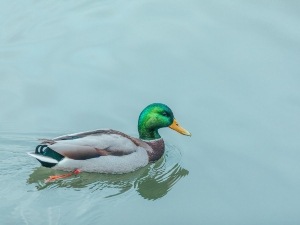
A swollen foot in humans can develop because of a variety of reasons, including being pregnant, eating salty foods, or being overweight to name a few, this isn’t the case for ducks.
If your duck’s foot is swollen then read on to find out why.
Table of Contents
Duck foot swollen
A change in your duck’s appearance or behavior is a sign that there is something going on with your bird, it is a sign that there is a change in your bird. This change can be good or bad and in the case of a swollen leg in ducks, it can be bad.
Below are reasons why your duck’s foot is swollen.
Bumblefoot
If your bird’s foot pad becomes injured and the wound becomes infected then the bird may develop bumblefoot. This condition can develop in birds who’ve suffered a slight cut or abrasion on their foot pad, usually on the underside.
Bumblefoot develops as a result of a staphylococcus bacteria infection. If this bacteria is allowed to enter into the opening on the skin of the bird’s foot then it will quickly multiply and cause the bird’s foot to become swollen.
The infection, just as with other infections, causes swelling and pain, a scab will form over the wound as well.
Bumblefoot can be treated and treatment methods are often quite successful but if left untreated for too long, it may lead to permanent damage.
What to do
You or your vet can treat your bird for this infection. If you choose to treat the bird at home you’d need to lance the bump on the bird’s foot and remove the puss.
Before lancing makes sure to wash the bird’s foot and then disinfect it using an iodine solution. Once the foot is clean, you can lance the bump using a sterile and sharp scalpel and then press the pus out.
Once you’ve removed all the pus you can flush the opening using a diluted iodine solution and then cover this opening with a pad.
Giving the bird antibiotics will also help, you’d need to contact a vet to gain access to antibiotics for the bird.
If your duck’s foot is swollen and painful because the bird has bumblefoot you also have the option of taking the bird to the vet.
The vet will lance the bird’s foot and then get the puss out of the bird’s foot, antibiotics will also be given. The vet will also suggest that the bird take probiotics after the course of antibiotics or during the course at different times.
Once the bird’s foot has been lanced, the puss has been removed, and the pad has been applied you should try to keep the bird’s weight off of the bird’s foot.
You can do this by making a cast for the bird or cutting up a tennis ball and placing it on the bird’s foot.
Injury
Your ducks’ foot pads are quite sensitive and soft, which makes them susceptible to serious wounds or cuts.
A duck’s body and a human’s body work the same when injured. When injured, the body sends white blood cells to the site of the injury and this causes redness, swelling, and heat.
Unexpected injuries can develop during playing, fighting, moving around, or coming into contact with jagged objects, sticks, rocks, and rough terrain. Any of these can injure the bird’s foot and cause the bird’s foot to swell up.
What to do
If the bird’s foot becomes injured and develops an open wound then you’d need to treat this quickly before an infection develops in the bird’s foot. Start off by gently yet confidently catching the bird, try to avoid startling the bird as this can make the injury worse.
After this, clean the wound using an iodine solution and then apply an antibiotic treatment to the wound. Bandage the wound after applying the treatment.
Bacterial infection
Ducks can develop bacterial infections other than bumblefoot. Bacterial infections can not only cause the bird’s foot to swell, but they can cause the bird’s hock and ankle to swell as well.
The swelling will be accompanied by redness and heat in the area, swelling develops where white blood cells are sent to fight an infection.
What to do:
The best way to treat your bird’s bacterial infection is to take the bird to the vet. Figuring out which bacterial infection your bird has, on your own can take too long if you can find it at all.
Taking your bird to the vet is recommended as the vet can quickly and easily diagnose your bird and offer the correct antibiotics.
If you enjoyed this article then you may also be interested in other duck related articles. Here are some articles that you may be interested in: Duckling feet turned inward, Duck dragging leg, How to splint a ducks leg, How to keep ducks safe on a pond

